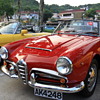Posted 11 years ago
 vetraio50
vetraio50
(756 items)
The topic is gardens for the last couple of cards from Hampton Palace. The land near the Thames is quite fertile in the Hampton area. The Knights Hospitalier had a barn there that they handed over to Cardinal Wolsely with 2000 acres of land.
Wolsely created a garden described in verse like this:
"My galleries ware fayer both large and long,
To walk in them whan that it lyked me best;
My gardens sweet, enclosed with walles strong,
Embanked with benches to sytt and take my rest;
The knotts so enknotted, it cannot be exprest,
With arbors arid alyes so pleasant and so dulce,
The pestylent ayers with flavors to repulse."
Henry VIII had fabulous gardens on the southern side of his palace known as the Pond Garden and the Privy Garden. The Privy Garden was an orangery that reached 157 feet long. Originally it held orange trees which on summer days stood out on the terrace opposite the garden.
But the real gardeners were William and Mary. They collected plants with a real passion. Their collection of plants numbered over 2,000 species collected from all over the known world. Mary had her own botanist Dr Leonard Plukenet to look after them. He maintained a detailed catalogue of one of the largest private collections of exotic plants in the world. There were extensive glass houses to protect them from the English cold.
When Mary died suddenly, William pulled these glasshouses down and had Christopher Wren create a new building for the collection some time later in 1701-2. The work was completed by Queen Anne after the death of William. Later the 'Lower Orangery' as it was known was used to house a sculpture collection. These days it is space that can be used for wedding receptions.
Black and white post card photograph of the Orangery and South Front, Hampton Court Palace, no. 12533 by Gale and Polden Ltd., London, Aldershot and Portsmouth. The post card is undated and unused, but others in the same series 'The Wellington Series' appear to date from circa 1900.
In the bottom right hand corner you can see one of those new fangled automobiles too!


























Many thanks MIKELV 'n PHIL too!
Many thanks MANIKIN!
Your welcome :-) Wondering if your growing these great old postcards . Wonderful collection and love them all !
Thanks MANI! I'm ready to start on a new bunch today.
Thanks to you too KAREN!
Many thanks AGHCOLLECT!
Many thanks VIOLETORANGE!
stunning history and building as well !!! very well done Kevin of putting this post together!!
Many thanks SEAN 'n INKY!
Many thanks TOM!
Many thanks ANNELANDERS!
Great story! Flowers are special. The rich need a break from stress also! A garden is a great place to relax!
Many thanks DON!
Many thanks GEO 'n ANTIQUES IN NJ too!
Your very welcome Kevin!!!
Many thanks SEAN 'n KERRY10456 too!
Styles seem to span at least 3 centuries. Another good poste.
Poem says, "pestylent ayres with flavors to repulse". I assume that means pestilence airs that repulse. Wonder what plants those would be? I won't swear to the advertised effectiveness of marigolds for repulsing mosquitoes. Maybe they knew more than we do now.
There are accounts for roses (at 4d. the hundred), violets, primroses, 'gilliver-slips, mynts, and other sweet flowers,' 'rosemary of 3 yeres old,' and Sweet Williams (at 3d. the bushel); but the chief decoration of a Tudor garden consisted of anything but flowers. In the walled parterres there were no doubt sheltered alleys and arbours; among the items in Wolsey's accounts is one for 'twix to bind therber,' but the embellishments were chiefly carved and painted heraldic 'beasts'.
That last comment was taken from here:
http://www.british-history.ac.uk/report.aspx?compid=22209
hey were made of perishable material, such as wood-trellis planted with creepers, vines, roses, or honeysuckle, therefore even those which were not pulled down purposely, must have been long ago destroyed by time. And what is also much to be regretted is, that few, if any, examples are to be found in English illuminated books, although pleuty of pictures occur in foreign MSS. of this period, especially French and Flemish. The scarcity of English examples is no doubt partly owing to the destruction of religious books at the time of the Reformation.
The reference for that one is here:
http://bookdome.com/gardening/History-Gardening-England/Early-Tudor-Gardens-Part-2.html
iPad problem with copying mate. Sorry!
So maybe the thorns were to repulse the enemy?
These places were private places to retreat to after public life.
Mediaeval gardens have huge significance.
Have you read the Decameron?
Tales told while trying to escape the 'plague'.
Non. I certainly can't find it here, even in the library.
This is a site devoted to it ....
http://www.brown.edu/Departments/Italian_Studies/dweb/themes_motifs/plague/
Interesting about the garden, flowers etc. & the plague. Tells me they were desperate to believe in anything that might spare them the plague.
Many thanks VIRGINIA VINTAGE, BLUNDERBUSS, ANTIQUES IN NJ, MANIKIN 'n POPS52 too!
Many thanks to you vetraio50, thanks for share with us so interesting items!
Many thanks ELISABETHAN!
Many thanks TED STRAUB!
Many thanks GARGOYLECOLLECTOR!
Many thanks GARY!
Many thanks PETEY!